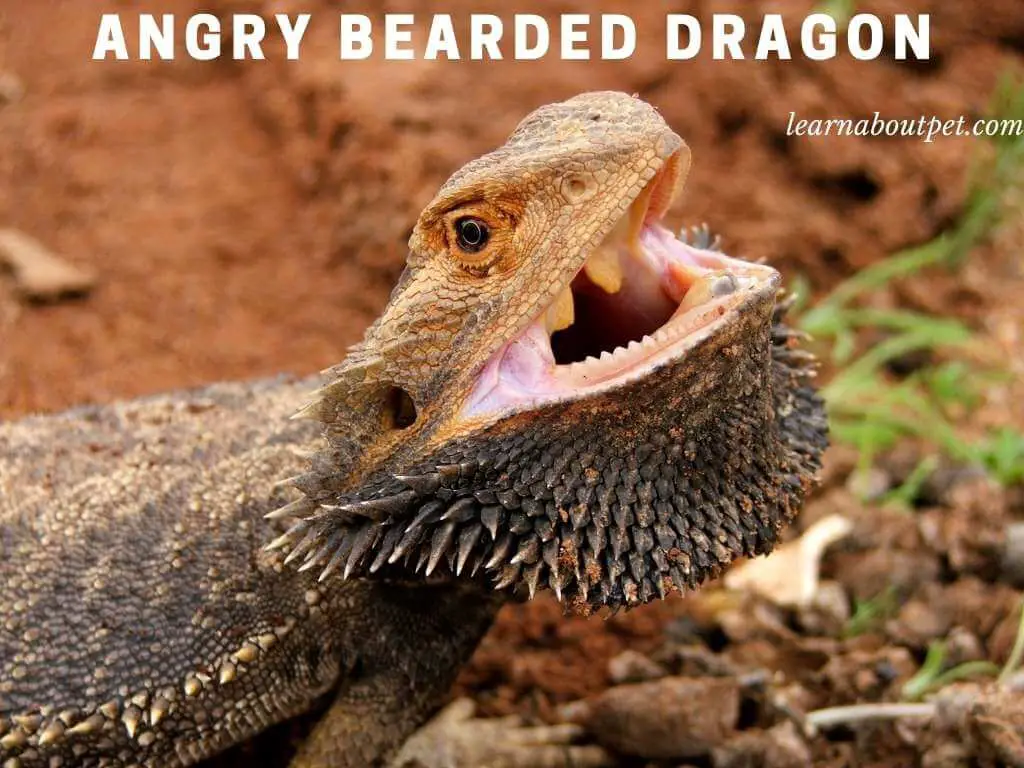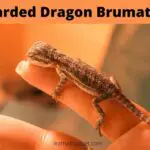Many people ask the question, Are bearded dragons aggressive? Yes, they can become aggressive because of many reasons, like when they are in brumation, sickness, and hormonal imbalance. They can also become aggressive in breeding seasons.
Are bearded dragons aggressive? Yes, they are aggressive, but this is not natural behavior. The sign of aggressiveness in behavior makes them worse. When they are aggressive, then they may try to bite. They can also hiss when they sense any threat.
This article will discuss angry bearded dragon behavior, how we can calm angry bearded dragons, and why my bearded dragon is angry. Let’s dive into the details of the angry bearded dragon.

How To Make A Bearded Dragon Mad
Many reasons are there that will make bearded dragons mad. Stress may be the reason for an angry bearded dragon. They got angry, and they tried to bite. Bearded dragons have a sensitive nature. When they feel any changes in their surroundings, they are not adaptable to that change and get mad.
There are a couple of things that you can do to make your Beardie mad. You should refrain from doing these things. They will not get along with other pets, especially dogs and cats. Moreover, they may even attack their owners who try to keep them in captivity as well. If you want to see the true colors of a bearded dragon, you should check out this article .
Beardies in the wild are pretty much free. They are not used to being held by people like dogs and cats may be. As such, it is very possible that they will eventually get upset because of their captivity and try to bite anyone near them including their owners.
Even if they have lived with humans for a long time, they will still get upset from being held captive. Hence, the best thing to do would be to leave them alone for awhile and let them roam freely inside their cages.
If you are thinking of buying a bearded dragon as an exotic pet, then just make sure that you also have space in your home for a cage so you can let your bearded dragon roam freely. You should also make sure that the cage is big enough such that they can move around freely and have some space to themselves.
Beardies are not like dogs or cats, they will not even need human companionship because it does not really occur in the wild. Hence, if there is no need for companionship in the wild, there is no reason for it to occur in captivity as well. It may even cause stress to Beardies who are used to living freely like dragons.
What Does An Angry Bearded Dragon Look Like
Naturally, the bearded dragon is not aggressive, which makes the bearded dragon a good pet. When you see the aggressive behavior of bearded dragons, then you may call them the worst. It is because an angry bearded dragon shows the worst behavior.
Other than the fact that they will be mad, Beardies that are angry will look pretty much like any other bearded dragon. The only difference is their attitude and temper tantrums. Some of them may even get aggressive especially if kept in captivity where they have no space to roam freely or with other pets who could be a source of stress for them.
Why Is My Bearded Dragon So Angry?
Do bearded dragons love their owners? The bearded dragon is very famous for being friendly and docile for owners. Many pet keepers say that they show aggressive behavior when the winter season arrives. You will notice mad behavior in the season of mating and when a male is about to sexual maturity.
There are a number of reasons why your bearded dragon is getting mad, just in case you ever find yourself in such a situation. One of the most common reasons for an angry bearded dragon can be that they have been captured and kept as pet for awhile now but never get to roam freely like real dragons in the wild. They will get mad at you if you keep them in small cages or terrariums.
If a bearded dragon is kept captive for too long, it will get used to not roaming freely and having space to itself. They can even get used to being with other pets which are usually stressful for Beardies because they can fight against each other for territory and food. Just like how humans get used to living in small spaces, Beardies will eventually get mad if they are kept captive for many years.
Another reason why a bearded dragon gets mad is because it is stressed out. If you are keeping your Dragon with other pets that they find stressful, then expect them to get angry at you and even bite you if they are angry enough. You should try to keep them with pets who are calm and quiet so they can get used to their presence easier and not get mad at you when you are near them.
If your bearded dragon is kept in a small enclosure or terrarium, then it will eventually suffer from stress which causes chronic health issues like lack of appetite, loss of appetite, weight loss and even death.
If you notice that your dragon is getting upset or being aggressive in captivity, then it would be best to get an expert’s advice right away on how you can prevent more problems from happening.
Bearded dragons also get mad if they have been restrained when they are still babies and never had the opportunity to roam freely as they grow.
If you are not planning on keeping them as your pet and just have them as a project for your own education, then it would be better to leave the dragon in its natural habitat because there is no way you can keep such a big creature confined like a pet when they have been roaming freely for years.
How Do You Calm An Angry Bearded Dragon?
You can calm an angry bearded dragon in many ways through training your pet beardie. The most appropriate way is to remove your angry bearded dragon from stress. Try to use these steps that make the bearded dragon more secure. You can use many other strategies that make them calm.
There are a few things that you can do to calm down your dragon after it has gotten mad. You should not be in the same room with them when they are upset because this could cause greater distress for them.
If your bearded dragon is getting mad at you, then try not to make eye contact with them. Instead, put away your hand and leave them alone to calm down, especially if they have been held captive for a long time.
There is no need to keep trying to calm down your dragon and make it go to sleep if it is already upset. They will just bite you after awhile anyway if they still get upset from being around humans or pets. It is best to leave them alone after they have calmed down and wait till the next day before you try to interact with them again.
Just like humans, Beardies also need time to cool off after getting upset which can be done in their cage. You should not expect that they will still want to cuddle or play even just a few minutes after they have gotten upset.
If your beardie is getting mad at you or your other pets, then make sure that you avoid contact with them for awhile and just let them calm down on their own in their cages. It is also best to keep the intensity of light for them low so it will not be stressful for them as well.
If your bearded dragon is getting upset at you for any reason and you are not sure what to do, then it would be best if you just leave them alone. You should also get an expert’s advice on how to escape the situation without being bitten by them because even their bites are pretty painful. If possible, find out why they are getting upset and try to avoid the reason.
Next time you are planning on interacting with your bearded dragon, just remember what this article has said so you can escape from being bitten by them easily.
You should be able to enjoy their company if Beardies are not mad at you or anything else bothering them that would make them bite people easily. They will not bite like other types of lizards like the leopard gecko which are quite docile and calm.
What Happens When Bearded Dragons Get Mad?
When bearded dragons get mad, then they show aggressive behavior. When a bearded dragon becomes angry, then it will rush to bite you. It would be best if you calmed angry bearded dragons in many ways by eliminating stress.
When bearded dragons are mad, then they would pout their lips and puff up with air as if to make themselves look bigger or tougher to ward off other animals. The stronger they look, then they are confident that other animals will not want to fight with them.
When bearded dragons get mad or angry, then they will open their mouths and wave their heads aggressively at each other in a challenging manner. This is how the male bearded dragons show dominance over each other when they compete for territory and food.
When bearded dragons get frustrated, then they will seek out a secure place to vent their frustration. It is best if you give them something, such as a rock or stick as an outlet for their frustrations.
When bearded dragons get angry, then the dragons would gape off of something that makes them mad or upset by opening and closing their mouth repeatedly at it in a very rapid manner. This is a sign for the other animal to stay away from their territory or they would bite them.
Signs of Aggression and Territorialism of Bearded Dragons
The following are signs of territorial aggression and aggression in general:
Hissing – The bearded dragon will hiss and puff out its beard.
Tail Wag – They will rapidly wag their tails when they are ready to fight.
Neck extending – The bearded dragon extends his neck to see what is going on around him or her.
Closed Mouth – The bearded dragon shows signs of comfort by keeping the mouth closed, but he/she is ready to engage at any moment.
Lifting up – The bearded dragon lifts his/her body from the ground or rocks and lets it stay in the air. It also shows that they are ready to attack, but not to run away.
Body Tossing – When they notice danger, then they will lift their bodies in the air and then toss it, which is a way to tell others that they are ready for battle.
Biting – The bearded dragon bites its closest target after puffing up their beard.
Flicking of Tongue – They flick their tongue out for one reason only, which is sense of danger. They are able to smell or hear the approaching attacker and it’s their way of telling you that they sense something bad is coming for them.
Clutching – The bearded dragon clutches objects around it as if preparing for a fight or to run away from the impending threat, which means they are not ready to engage yet.
Hanging Limbs – The bearded dragon hangs their limbs in the air while hissing as they sense danger. This may appear that they are not ready for a conflict, but it’s simply their way of telling you to back away from them and give them time to think through the situation.
Tail Wiping – They wipe their tails on the ground when they are feeling a conflict about to happen.
Ears Back – It is a sign of one’s submission, which simply means they want you to back away from them or give up your attention towards them.
Puffing – The bearded dragon puffs out his/her beard to show that something is going on with them and they want privacy.
Rolling over – It is a sign of submission, which means that the bearded dragon will allow you to touch him/her as long as he gets some time alone.
How To Avoid Angry Bearded Dragon Bite?
When bearded dragons get angry, they will show signs like tail twitching, hissing, and biting that tell you that a bearded dragon becomes angry. You can try different techniques to calm angry bearded dragons.
Are bearded dragons aggressive? When you are picking angry bearded dragons, then they will show a fight response. That is why you need to be extra conscious to save yourself from the bite. You can use cloth for picking them and put them in the tank. For decreasing the overstimulation, you can cover the habitat of a bearded dragon with a towel.
Here are some tips on how to avoid angry bearded dragon bite.
To calm down an angry bearded dragon, you can try different techniques including moving your hand closer to the ground slowly until you see that your beardie relaxes and stops hissing and biting.
Next, lay down on the floor and let your beardie walk around freely in the room. You can also try these techniques when you see that your beardie is angry and has been in an upset mood for a long period.
If you keep on moving your hand or if he still feels angry, then retreat to another room and leave him alone there for about 5 minutes. After five minutes, take him out of the room and allow him to free in the other room. If your beardie still angry, repeat this process for some time until you see that he calms down.
How To Pick Up An Angry Bearded Dragon?
It would be best if you had good techniques to pick your angry bearded dragon. When an angry bearded dragon gets aggressive, it can harm your fingers or other soft flesh. In aggressiveness, they wrap their legs and tail around their hand and then bite forcefully. I suggest that when the bearded dragon is in angry behavior, you don’t pick up until they calm down.
You can wait until they move around then move your hand slowly. Always watch out for their environment when you have them in hand, and be aware that bearded dragons might bite if provoked.
If the bearded dragon is scared or intimidated, try to pick it up with a towel so its body will not make contact with your skin directly. Bearded dragon bites can cause swelling and infection, so the best way to avoid that is to wear gloves. If you don’t have a pair of gloves, using a towel or cloth will do.
When someone gets frightened, their body shakes uncontrollably and people may associate it with aggressiveness in pets like bearded dragons. Just remember that bearded dragons shake when they are frightened or afraid.
Bearded dragons can take several steps to get away from people, especially when they feel threatened. When you are looking for the bearded dragon and not expecting it will jump into your hands, because the danger is approaching. You should always be aware of their behavior so you can catch them safely before anything else happens.
Mad Bearded Dragon Hissing, What Does It Mean?
When a bearded dragon feels any threat, they start hissing you; it simply means they want privacy. Hissing may be due to seeing his reflection. Lack of water and adequate food makes them more upset. Anxiety and fear make them angry. When they meet all needs, then the amount of hissing will be lowered.
Does Angry Bearded Dragon Reduce Its Lifespan
Species, size, sex, enclosure, diet, and breeding impact the lifespan of bearded dragons. The bearded dragon that lives in the wild has more life expectancy than the bearded dragon that is live-in home. Food shortage and predators are the major reason behind the difference in lifespan.
Keeping your pet beardie happy will improve its lifespan, although I don’t have any scientific research to back up the fact.
How Does A Sad Bearded Dragon Look Like?
A bearded dragon can get angry when seeing any changes from normal things. The most common reason for aggressive stimulation is lack of food, and fear of any things makes them sad; hence, bearded dragons get angry and then sad.
Sad bearded dragons may appear nervous. It becomes sluggish. While sleeping, it doesn’t move much. You might see its eyes wide open. Discontinuing food and water make them more depressed too.
I Constantly Hear Bearded Dragon Hiss. Is He Angry?
If you are constantly hearing the hiss of bearded dragons, then it means that the bearded dragon is angry. Bearded dragons start hissing only when they feel any threat.

What Are The Reasons That Make Bearded Dragon Mad
Bearded dragon aggression can be due to many reasons. Hormones, any environmental changes, and anything from daily routine can make bearded dragons mad. The following are details about reasons to get a bearded dragon mad.
Hormones
Hormonal changes may be the reason for the bearded dragon’s aggressive behavior. This can happen in both genders of bearded dragons. In females, aggressive behavior may be during the bearded dragon ovulation period.
Male also get angry with another male for competition to attract a female. This type of behavior can be seen at an early age, at the age of six months.
Environment Changes
Environmental changes may be the reason for aggressive baby bearded dragon behavior. Some owners say that my bearded dragon is mean; this can be due to any addition or removing anything in the external environment. Even a minute change may lead to the aggressive behavior of a bearded dragon.
Furniture, new accessories may be the reason for the angry baby bearded dragon. They are not easily adaptable to new environments. When there is any change in a tank of the bearded dragon, then the mad baby bearded dragon reacts differently. They need about two to three months to adjust themselves to a new environment.
Scared Bearded Dragon
Mad bearded dragons react in different ways and madness maybe when they feel any threat from the surrounding. When they see anything that makes them scared, then the bearded dragon aggressive all of a sudden, and they show uncanny behavior.
A mad bearded dragon starts running around the tank, and in this way, they injure themselves. This can be seen in many bearded dragons. A bearded dragon may react differently if you wear new clothes because they also feel scared from new clothing. Aggressive behavior is the reason not to get a bearded dragon.
Breeding Season
Some people ask that bearded dragon mad at me; this can be in the breeding season. In breeding season, you will see a little change in the behavior of bearded dragons.
Male bearded dragons may get aggressive behavior when they fight for the female. Bearded dragons can bite in this situation. If you want to calm them in this situation, then it can be dangerous for you.
Bearded dragon personality may change during the breeding season. When bearded dragons are near breeding season, then you should separate male bearded dragons from each other.
Female dragons are also aggressive when they reach near maturation. About near six to eight months, you can see different behavior of bearded dragons, and aggressive bearded dragon female’s behavior can be seen.
New Bearded Dragon
When bearded dragons are new, then they will get stressed and scared due to many things. You should be patient until they are familiar with you. Once they are familiar with you, then they become friendly and docile.
When you try to handle a new baby dragon, then don’t grip them from the top. When you try to catch him from the top, they get threatened, resulting in aggression in the bearded dragon. You should give them enough time to become friendly with you.
When they try to open their mouth, then you will have to give them a treat. Good treats make them make friends with you.
Different Temperament
Bearded dragons have different temperaments. But you will see the friendly and docile behavior in many bearded dragons. But some may be intolerant, but this is due to many reasons. They are friendly by nature, but any change in environment or any other things may result in the aggression of bearded dragons.
After three to six months, if bearded dragons are not used to the habitat where they live, then there may be some problems. You should review all the habitats or living conditions of bearded dragons. It would be best if you also changed the diet because diet can be the reason for this.
Shedding
Shedding can be the reason for aggressive behavior in bearded dragons. Shedding can cause mood swings. That is why there is a decrease in the appetite of bearded dragons, and they refuse to consume edibles.
Brumation Start
Brumation is a natural adaptation in bearded dragons and many other reptiles, in which they hibernate to save themselves from harsh extreme conditions. Bearded dragons will refuse edibles, are lethargic, and their sleeping duration may be increased.
This behavior can be seen at the age of twelve to eighteen months. In the winter season, this type of behavior can be seen. Bearded dragons sleep a lot in the winter season.
Wrong Setup
How do I know if my bearded dragon is angry? If the habitat or setup of a bearded dragon is not okay for them, it may result in aggressive behavior.
You need to provide all the things that are essential for them. If the tank’s temperature is too high or too low, it may result in aggressive behavior. You can use a heat emitter in the tank to maintain the optimum temperature of bearded dragons.
If there is any light in the tank, then bearded dragons cannot sleep, and there is a change in the behavior of bearded dragons.
Sickness
If bearded dragons are sick, then it may result in discomfort and pain that make them uncomfortable. Their behavior suddenly changes. You would start noticing perplexing behavior like constipation, soft bones, spasms, no appetite, lethargy, etc.
Hunger
Bearded dragon madness may be due to appetite. You should be extra conscious about the diet of bearded dragons. You should make proper food for them because bearded dragons love treats when they will not eat any things they feel like and hence it may result in behavior changes.
If the bearded dragon is at an early age, you should give them food for twenty minutes. It depends upon bearded dragons how much food they can eat in these twenty minutes. If there are adult bearded dragons, then you should give them fifteen to twenty fattier worms for feeding.
How To Calm An Angry Baby Bearded Dragon
The most asked question is how to tame an aggressive bearded dragon. The most important thing is that when they are fighting with others, then you should not carry or catch them in this situation because it may harm your hand and fingers.
You should give them a good treat to make them calm. Habitat taking care is also the way that makes them comfortable. You should give them proper heat in the tank because they need heat at night. Any temperature change may result in the aggressive behavior of bearded dragons.

You should give them the proper time and duration of sleep. Sleep duration should be about eight to twelve hours. If there is any light in the tank, then they are not able to sleep. That is why you will have to provide complete darkness for proper sleep. Sleeping plays an important role in the growth and development of the body.
Final Verdict On Angry Bearded Dragon
Bearded dragons have friendly behavior. They are very loving to their owners. But they are very sensitive. Any change near them makes them aggressive and mad. Disturbance in the tank, environmental changes may lead to aggressive behavior.

Welcome to Learn About Pet. My name is Rajkumar Ravichandran and I love all pets, travel, and amazing food. I write about my passion and personal experience caring for multiple pets in this blog! ❤️
Post Disclaimer
DISCLAIMER: THIS BLOG OR WEBSITE, "Learn About Pet", DOES NOT PROVIDE YOU WITH MEDICAL ADVICE AND IS NOT A SUBSTITUTE FOR MEDICAL ADVICE. ALWAYS GET IN TOUCH WITH YOUR PERSONAL VETERINARIAN AND USE INFORMATION HERE AS GENERAL ADVICE.
The information, including but not limited to, text, graphics, images and other material contained on this website are for informational purposes only. No material on this site is intended to be a substitute for professional veterinary advice, food recommendation, diagnosis, or treatment. Always seek the advice of your veterinarian or other qualified health care provider with any questions you may have regarding a medical condition or for pet food related questions.







